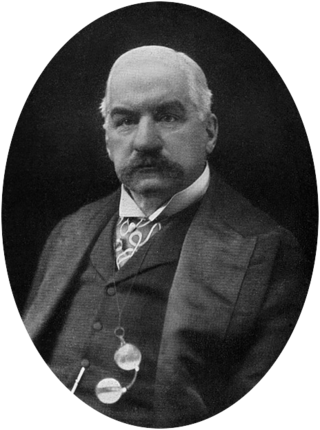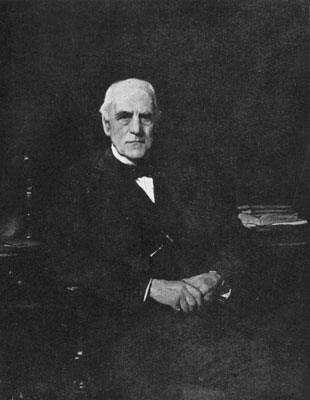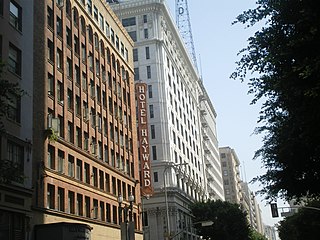Related Research Articles

Wall Street is an eight-block-long street in the Financial District of Lower Manhattan in New York City. It runs between Broadway in the west to South Street and the East River in the east. The term "Wall Street" has become a metonym for the financial markets of the United States as a whole, the American financial services industry, New York–based financial interests, or the Financial District itself. Anchored by Wall Street, New York has been described as the world's principal financial and fintech center.

John Pierpont Morgan Sr. was an American financier and investment banker who dominated corporate finance on Wall Street throughout the Gilded Age. As the head of the banking firm that ultimately became known as J.P. Morgan and Co., he was the driving force behind the wave of industrial consolidation in the United States spanning the late 19th and early 20th centuries.

Frank Heyling Furness was an American architect of the Victorian era. He designed more than 600 buildings, most in the Philadelphia area, and is remembered for his diverse, muscular, often unordinarily scaled buildings, and for his influence on the Chicago architect Louis Sullivan. Furness also received a Medal of Honor for bravery during the Civil War.

The Panic of 1907, also known as the 1907 Bankers' Panic or Knickerbocker Crisis, was a financial crisis that took place in the United States over a three-week period starting in mid-October, when the New York Stock Exchange fell almost 50% from its peak the previous year. The panic occurred during a time of economic recession, and there were numerous runs on banks and on trust companies. The 1907 panic eventually spread throughout the nation when many state and local banks and businesses entered bankruptcy. The primary causes of the run included a retraction of market liquidity by a number of New York City banks and a loss of confidence among depositors, exacerbated by unregulated side bets at bucket shops.

Junius Spencer Morgan I was an American banker and financier, as well as the father of John Pierpont "J.P." Morgan and patriarch to the Morgan banking house.

Anthony Joseph Drexel Sr. was an American banker who played a major role in the rise of modern global finance after the American Civil War. As the dominant partner of Drexel & Co. of Philadelphia, he founded Drexel, Morgan & Co in New York in 1871 with J. P. Morgan as his junior partner. He also founded Drexel University in 1891. He was also the first president of the Fairmount Park Art Association, the nation's first private organization dedicated to integrating public art and urban planning.

John Vernou "Black Jack" Bouvier III was an American Wall Street stockbroker and socialite. He was the father of First Lady Jacqueline Kennedy Onassis and of socialite Lee Radziwill, and was the father-in-law of John F. Kennedy.

The Panic of 1884 was an economic panic during the Depression of 1882–1885. It was unusual in that it struck at the end rather than the beginning of the recession. The panic created a credit shortage that led to a significant economic decline in the United States, turning a recession into a depression.
The Manhattan Company was a New York bank and holding company established on September 1, 1799. The company merged with Chase National Bank in 1955 to form the Chase Manhattan Bank. It is the oldest of the predecessor institutions that eventually formed the current JPMorgan Chase & Co.

"Too big to fail" (TBTF) is a theory in banking and finance that asserts that certain corporations, particularly financial institutions, are so large and so interconnected that their failure would be disastrous to the greater economic system, and therefore should be supported by government when they face potential failure. The colloquial term "too big to fail" was popularized by U.S. Congressman Stewart McKinney in a 1984 Congressional hearing, discussing the Federal Deposit Insurance Corporation's intervention with Continental Illinois. The term had previously been used occasionally in the press, and similar thinking had motivated earlier bank bailouts.

Spring Street in Los Angeles is one of the oldest streets in the city. Along Spring Street in Downtown Los Angeles, from just north of Fourth Street to just south of Seventh Street is the NRHP-listed Spring Street Financial District, nicknamed Wall Street of the West, lined with Beaux Arts buildings and currently experiencing gentrification. This section forms part of the Historic Core district of Downtown, together with portions of Hill, Broadway, Main and Los Angeles streets.

Wilson Brothers & Company was a prominent Victorian-era architecture and engineering firm established in Philadelphia, Pennsylvania. The company was regarded for its structural expertise. The brothers designed or contributed engineering work to hundreds of bridges, railroad stations and industrial buildings, including the principal buildings at the 1876 Centennial Exposition. They also designed churches, hospitals, schools, hotels and private residences. Among their surviving major works are the Pennsylvania Railroad, Connecting Railway Bridge over the Schuylkill River (1866–67), the main building of Drexel University (1888–91), and the train shed of Reading Terminal (1891–93), all in Philadelphia.
Consolidated Indemnity and Insurance Company was a Hartford, Connecticut-based firm which became insolvent during the Great Depression. The corporation is important because it employed executives who were formerly directors of significant business concerns of New York City, in the early 1930s and before. Consolidated Indemnity and Insurance Company was organized in October 1928 with a capital of $2,500,000 and a surplus of $7,300,000. Among its fifteen directors were Saul Singer, vice-president of the New York Bank of the United States and C. Stanley Mitchell, president of the Central Mercantile Trust Company. Its president was John F. Gilchrist, chairman of the Tate Transit Commission. Gilchrist was a close personal and boyhood friend of Alfred E. Smith.
Insull Utilities Investment Inc. was a corporation securities firm based in Chicago, Illinois which became insolvent in 1932. It was formed in December 1928 with assets of $23,000,000 to $24,000,000. The firm was started by Samuel Insull, a former president of Chicago Edison, Commonwealth Edison, People's Gas Light & Coke Company, and Central Indiana Power Company. He was also chairman of the Corporation Securities Company of Chicago, which had a net worth of more than $80,000,000 on February 15, 1930. The latter business was created to acquire securities of Insull Utilities Investments and other Insull operating and holding companies.
The National Cordage Company was formed in New Jersey in 1887, for the importation of hemp and the manufacture and sale of cordage. It is noteworthy because of its expansion at the beginning of the 1890s and its initial public offering of $5,000,000 of 8% cumulative preferred stock. The corporation sought to decrease the cost of production and distribution of their products. It issued a prospectus on August 1, 1887 and quickly sought to dominate the market in raw materials.

Armington & Sims Engine Company was a manufacturer of steam engines located in Providence, Rhode Island. It was established in 1881 by Pardon Armington and Gardner C. Sims. The factory was located at the corner of High Street near Knight in Providence.
E. W. Holbrook & Company was a New York City dry goods firm which became bankrupt in July 1883. Located at 51 Leonard Street, near Broadway (Manhattan), in Lower Manhattan, the business was among the most well-known of its kind. The company, led by Edwin W. Holbrook and three other directors, was in debt in the amount of $750,000 The failure was attributed to losses involved in the operation of its three cotton mills. Holbrook also lost $500,000 on Wall Street (Manhattan) in speculation. During the week of E.W. Holbrook & Company's insolvency, 162 other firms in the United States failed.

A clearing house is a financial institution formed to facilitate the exchange of payments, securities, or derivatives transactions. The clearing house stands between two clearing firms. Its purpose is to reduce the risk of a member firm failing to honor its trade settlement obligations.

James H. Freis Jr. is an American lawyer and financial industry executive who from 2007 to 2012 served as the United States Department of the Treasury's 6th Director of the Financial Crimes Enforcement Network (FinCEN), where he expanded the scope of the anti-money laundering regulations and became known for spearheading efforts to combat fraud and implementing modern data analysis. He was an attorney and central banker at the Federal Reserve Bank of New York and the Bank for International Settlements.

Greensill Capital was a financial services company based in the United Kingdom and Australia. It focused on the provision of supply chain financing and related services. The company was founded in 2011 by Lex Greensill. It filed for insolvency protection on 8 March 2021.
References
- ↑ Run On A Philadelphia Bank, New York Times, August 27, 1885, pg. 2.
- 1 2 Philadelphia Banks Fail, New York Times, May 9, 1891, pg. 1.
- ↑ A Bank Failure, Wall Street Journal, May 8, 1891, pg. 1.
- 1 2 Ten Years Each, Wall Street Journal, September 15, 1891, pg. 1.